Botswana is exceptionally unique in that it offers so many diverse landscapes and wildlife experiences – all in the same country. With enormous expanses of land dedicated to conservation and many of these unhindered by human settlements or boundaries, Botswana is the ultimate wildlife destination and has so many incredible places to visit! The iconic Okavango Delta (recently listed as the 1000th World Heritage site by the IUCN), Moremi Game Reserve, Linyanti Swamps, Savute and Chobe National Park are the main wildlife attractions, closely followed by the Central Kalahari Game Reserve, Makgadigadi & Nxai Pans
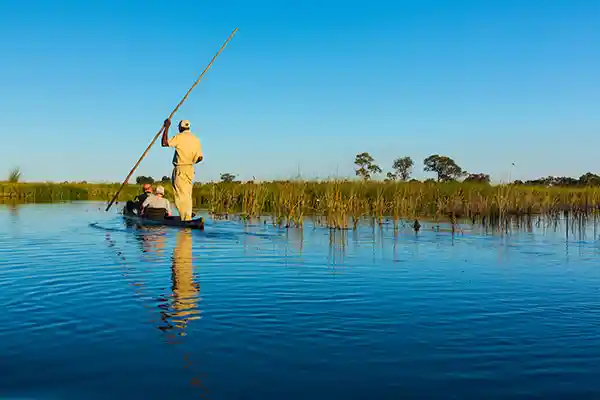
The Jewel of the Kalahari as it is often described; Africa Inbound Safaris agrees. This vast inland delta offers so much beauty and wildlife that it is mind boggling; one of the great spectacles of the planet, the Okavango Delta is truly an oasis in what is considered to be a desert.
An almost immeasurable amount of water flows through into the delta from the hills of Angola creating a unique ecosystem. A patchwork of papyrus swamps and islands to the north are fed by permanent channels, which spread like the fingers of a hand southwards. As the delta widens and fans out, the landscape changes to a myriad of palm fringed islands dotted in amongst flood plains. The central areas of land including Chiefs Island and the Moremi Game Reserve are larger landmasses that remain dryer than their surroundings during the height of the floods.
The Northern region of the Okavango Delta is referred to as the Panhandle and runs by the main town of Shakawe. This area is where you will find the permanent deeper channels lined by papyrus swamps and secret lagoons – the fishing here for bream and Tiger fish is amazing.
These permanent waters have of late run all the way down to the safari town of Maun and then on down the Boteti River and beyond. As the floods “fingers” stretch out, they slowly create an oasis of immense proportions turning surrounding areas from parched land scoured by a million dusty animal tracks to a verdant green and lush environment with game numbers equal to anywhere in Africa.
Perhaps the only region in the whole of the Delta area that can be considered as permanently “dry” are the Tsodilo Hills in the Panhandle area some 30km west of the permanent channels. Set in the Kalahari scrub bush these large rocky outcrops are unique in a largely flat landscape. They are culturally for the San people who used to live here and revered the area as a sacred and mystical place and left their mark with numerous rock paintings.
We believe that any visit to Botswana simply must include a visit to the Okavango Delta, its biodiversity and monthly adaptations provide for an astonishing range of animals, birds and flowers.
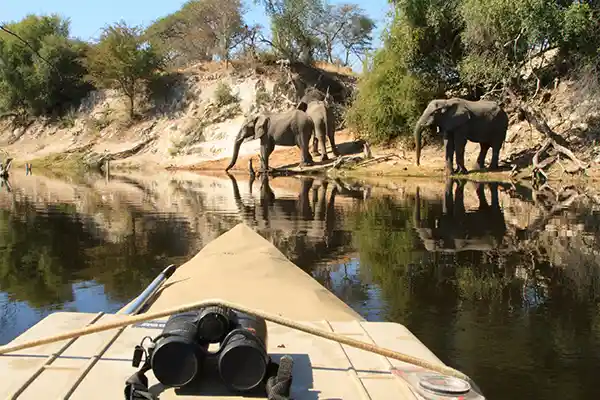
The famous Chobe National Park covers over 11,000km² and includes the Savute region. As the Kwando and Linyanti river sections wind their way through the northern edge of Botswana the river widens and becomes the Chobe river, one of the great rivers of Africa. Bordering the Northern edge of the National Park, this river quenches the thirst of large numbers of animals, thus making it one of the best places to see game in Botswana. Famous for its large herds of elephant and buffalo, the Chobe River front gives you perhaps the best sunsets, either seen by vehicle or fantastic boat cruise along the river.
The main entry point to the Chobe River front is the buzzing town of Kasane which is also the gateway to Victoria Falls in Zimbabwe and Zambia.
Within the National Park region are private lodges, which are generally situated along the Chobe Riverfront. Due to its proximity to Kasane, the riverfront can be busier than many of the private concession areas in Botswana, but none of these other areas present you with the spectacle that the Chobe River does.
The Park also caters extremely well for Mobile Camping Safari operators who have the benefit of the sole use of private camp-sites. These mobiles will often stay within the park for a few nights as part of a longer safari throughout Botswana and possibly its neighbouring countries
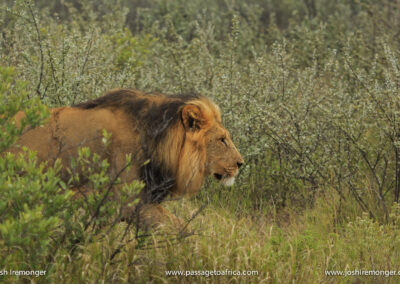
Classifying this area as a desert is a hard idea to take in for the average traveller, you will not find the classic wind-swept sand dunes anywhere here, nor will you see any camels padding their way into the distance. The area is generally a living desert, covered in grassland and bushveld scrub interspersed with salt pans and fossilised river beds.
At over 50,000 km², this vast delicate environment borders up to the Ghanzi area in the west but is dominated by the massive Central Kalahari Game Reserve (CKGR) stretching out to the east. Further out beyond the National Park borders of the CKGR you will find Khama Rhino Sanctuary, one of the few places that you will find the elusive rhino in Botswana.
The San Bushmen, having been in the Kalahari region for many thousands of years, leading a nomadic existence, applying the art of the hunter-gatherer with exceptional skill, have moved to the outskirts of the region as the CKGR gained prominence as a protected area and National Park. They do however form part of the attraction here and visitors to the region can be guided by bushmen and shown examples of their survival skills. The Kalahari can sometimes feel empty compared to regions such as the Okavango Delta – the magic of the Kalahari lies in the bushmen and what they can teach you about their natural habitat and survival skills in this apparently desolate region.
The Central Kalahari area is awe inspiring for its vista alone. Whereas in some areas the best time to visit is in the dry seasons of winter, from May to October Kalahari temperatures soar and the ground offers little water for the game, the area however, comes alive in the rainy season.
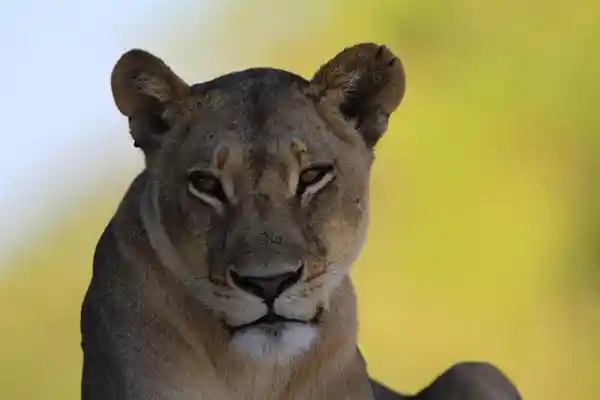
The Khwai community concession deserves special mention due to its proximity to the Moremi Game Reserve and the Okavango Delta, and the fact that it operates under different beneficial rules to most other regions.
This area is deemed to be a public concession and is of outstanding beauty and the diversity of game and vegetation is shared. Much smaller in size, its real benefit is accessibility, and differences in accommodation, which is mostly more affordable in terms of its lodges and its suitability for Mobile Camping Safaris.
The main border is along the Khwai River, the others being Moremi Game Reserve to the West, the entrance to the Savuti area to the north and a little-used area of the Chobe National Park. This concession is run by the members of the Khwai Village community and extends from their village to Mababe village to the east.
As ever, there are no fences around the neighbouring National Parks and the game is free to roam in and out as it wishes. Khwai is simply a superb area to view predators, particularly wild dog and leopard.

The Linyanti area in northern Botswana provides a great contrast to the Okavango Delta. The Linyanti is sandwiched between the Okavango Delta to the south and west and the Chobe National Park to the East. The northern area of the concession is formed by the mighty Linyanti River, which also forms the border between Botswana and Namibia.
Deeper into the area lies the Savute Channel, an ancient, unpredictable and slightly mysterious water course which flows from the Linyanti to the Savuti marshes in the Chobe National Park.
The northern section of the area features beautiful open floodplains and lovely riverine forest while the south is dominated with thicker mopane forest. The area is famous for the immense herds of elephants which flock to the waters in their thousands in the dry season. Buffalo herds can be staggering too. The dry season yields the best game viewing in this area, with good predator sightings – including lion, leopard, cheetah and even wild dog. The varied woodland and floodplain environments are home to a variety of species and offer an interesting safari experience.
The Kwando River flows from Angola into Botswana and, like the Okavango River, dissipates over the sand of the Kalahari Desert. This overspill of water forms the Linyanti Swamps and when there is a big flood, the swamps expand to form a delta, with papyrus and reed lined waterways and lagoons. A faultline drains the Linyanti Swamps into the Linyanti River, which ultimately flows into the Chobe River.
The Savute channel runs through the centre of the concession, west to east.
The area is one of diverse habitats which encompasses the Linyanti Swamps, grasslands and mopane woodlands. All of this adds up to breath-taking scenery and fantastic, prolific wildlife
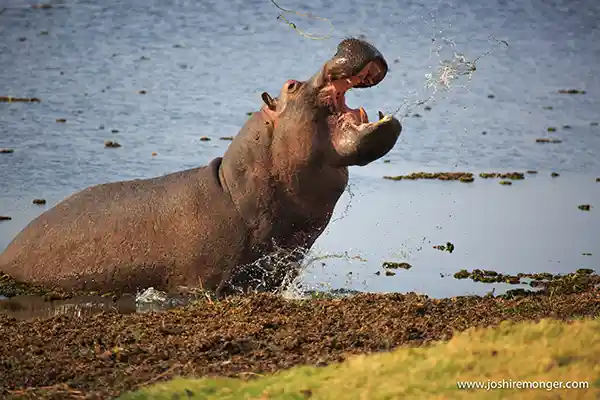
If you can imagine the Okavango Delta as being the shape of a hand, its waterways and seasonal floods spreading out like fingers as it enters Botswana from the north and spills southwards, the Moremi Game Reserve would be the palm of the hand.
Originally the royal hunting grounds of Chief Moremi, it was designated a Game Reserve in the 1960’s and whilst growing in size, has since achieved National Park status and as mentioned before is now a World Heritage Site.
It is the sheer diversity of fauna and flora and its differing landscapes that make this area such a highly desirable place to visit. There is arguably no-where else in Botswana that offers a myriad of lagoons, open dry areas, permanent water channels interspersed with Mopane forests and Palm fringed islands that sit in the middle of flooded plains.
There are no fences around the reserve and game is able to wander freely into and out of the park from the neighbouring private concession areas. North of the reserve itself are the dryer areas of the Okavango Delta region and south of the reserve are the wetter areas where the private concessions hold most of the water camps.
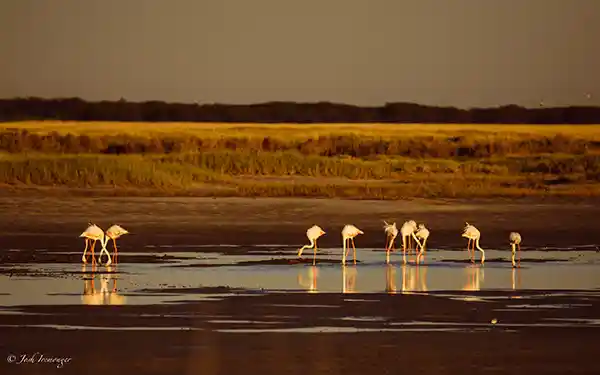
The Makgadikgadi Salt Pans to the centre of Botswana are as unpredictable as they are beautiful. The area is made up of the Makgadikgadi Pans National Park and the Nxai Pan National Park which are intersected by the main tarred Francistown road.
This arid and hot region of Botswana holds as many secrets and mysteries as the Okavango Delta does animals. An ancient place made up of many salt pans, the Makgadikgadi itself is an ancient lake bed. Approximately 3 million years old, this was once filled by waters flowing from the Okavango region until the formation of the Gumare fault, which lowered the land decreasing the levels of water flooding in.
Evidence of human habitation has been found in the form of fossil tools fashioned by prehistoric man, however, the area is now largely uninhabited with just a few villages and settlements on the outskirts.
The total Makgadikgadi Salt Pans area is made up of scrub and grassland, which is interspersed with salt pans of varying sizes, the largest of which being 5,000 km². The pans themselves can be massive and it is possible for the traveler to truly see nothing but the curvature of the earth for 360 degrees.
The conditions are often deceiving… a thin layer of bone dry crust may well hide a quagmire of mud. For many months of the year they keep up this arid appearance until the rains arrive from November onwards when the pans can look like the largest mirrors in the world. Vast areas are transformed into very shallow lakes, which attracts two astonishing spectacles:
Seemingly from pure instinct, thousands of zebra and wildebeest begin their migrations and end up at this water oasis. The landscape is transformed into a lush grassland. The second spectacle is the arrival of up to 250,000 breeding lesser and greater flamingos, generally settling in the east at Sua Pan giving the local Nata Bird Sanctuary an incredible yearly visual feast.
The area, bordered to the left by the Boteti River, usually dry but now in full flow, is another of Botswana’s unique environments, which offers up a very different landscape with very different game expectations. Landmarks such as the famous Baines Baobabs in Nxai Pan National Park, perhaps more majestic than those on Kubu Island, present the traveller with a side of Botswana that is not often seen but one that should not be missed.
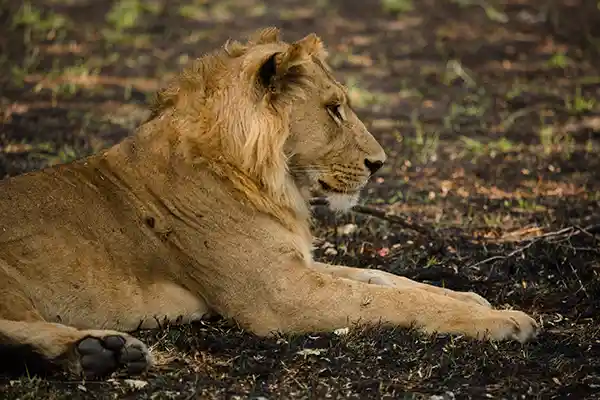
Savuti is part of the Chobe National Park and lies South of the Chobe River Front.
Travelling down from the river area and through the thick sands of the Chobe Forrest Reserve you approach the Ghoha Hills, this is where the majestic Savute begins. Technically part of the Chobe National park, it is a completely separate region to the Chobe River area where the game experience and the vegetation have little in common.
Bordered to the north by the Chobe Enclave and to the west by the Greater Linyanti Reserves, the Savuti Channel cuts in from the west and slowly feeds the Savuti Marsh. For many years this area had been very dry which certainly affected the game moving through. However now with the high seasonal floods and waters moving down the Selinda Spillway, the Savuti Channel is once again in flow.
The affects of this water have been dramatic. Since the flow began again in 2009, the Savuti Marsh in particular has become much more fertile and is bringing back the larger herds of buffalo and elephant as well as increasing the ever present zebra population.
Savuti is famed for its predators, from the leopards who trace down the dolomite rock formations of the Gubatsa Hills whilst klipspringers watch nervously, to the large lion prides known for having developed the skill of hunting elephants, behavior not generally witnessed in the rest of Africa, the Savute region is back to its prime as being known as one of the greatest game viewing areas on the continent.
The area is renowned for its extensive grasslands and savannah dotted with hills, some of which have evidence of former human habitation and rock paintings. An area of exceptional potential is only marred by the fact that is in within the boundaries of the National Park and therefore no night drives nor off-road driving is allowed.
Use the details below or the form provided to contact us so we can start building your next big adventure.
We can’t wait to hear from you.


(C) 2024 africainboundsafaris.com
Use the details below or the form provided to contact us so we can start building your next big adventure.
We can’t wait to hear from you.